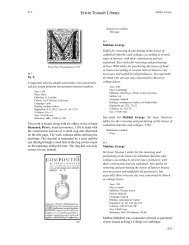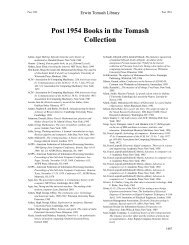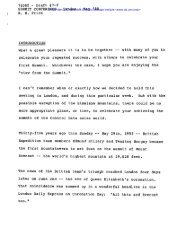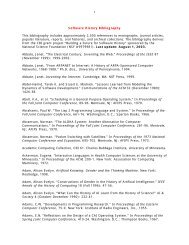B chapter.indd - Charles Babbage Institute - University of Minnesota
B chapter.indd - Charles Babbage Institute - University of Minnesota
B chapter.indd - Charles Babbage Institute - University of Minnesota
Create successful ePaper yourself
Turn your PDF publications into a flip-book with our unique Google optimized e-Paper software.
212<br />
Erwin Tomash Library<br />
Brooks, Edward Brooks, Edward<br />
Binding: original printed cloth boards<br />
Pagination: pp. viii, 231–429, [1]<br />
Collation: A–H 12 I 8<br />
Size: 184x114 mm<br />
This is Part III <strong>of</strong> Brooks’ advanced treatment <strong>of</strong><br />
arithmetic. This volume contains sections on business<br />
problems such as percentages on bonds and investments,<br />
ratios, arithmetic and geometric series, and menstruation<br />
<strong>of</strong> surfaces and volumes. An appendix contains problems<br />
on the metric system and insurance <strong>of</strong> various kinds.<br />
Illustrations available:<br />
Title page<br />
B 268<br />
Brooks, Edward (1831–1912)<br />
The normal written arithmetic, by analysis and<br />
synthesis. Designed for common schools, normal<br />
schools, high schools, academies, etc.<br />
Year: 1869<br />
Place: Philadelphia<br />
Publisher: Sower, Potts & Co.<br />
Edition: 2nd (?)<br />
Language: English<br />
Binding: original printed cloth boards<br />
Pagination: pp. vi, 9–337, [1]<br />
Collation: 1–28 6<br />
Size: 184x108 mm<br />
This is a more advanced work than Brooks’ mental<br />
arithmetic series. It treats the same elementary<br />
numeration and arithmetic operations, but then deals<br />
with decimal fractions and many <strong>of</strong> the same types <strong>of</strong><br />
advanced problems that were repeated in the union<br />
publications.<br />
Illustrations available:<br />
Title page<br />
B 269<br />
Brooks, Edward (1831–1912)<br />
The philosophy <strong>of</strong> arithmetic as developed from the<br />
three fundamental processes <strong>of</strong> synthesis, analysis, and<br />
comparison containing also a history <strong>of</strong> arithmetic.<br />
Year: 1880<br />
Place: Lancaster, PA<br />
Publisher: Normal Publishing<br />
Edition: 2nd<br />
Language: English<br />
Binding: original cloth boards<br />
Pagination: pp. x, 11–570, 2<br />
Collation: 1–35 8 36 6<br />
Size: 222x144 mm<br />
This is by far the most significant <strong>of</strong> Brooks’ publications,<br />
although perhaps the least popular. It begins with a<br />
history and comments on the origins and old names for<br />
arithmetical processes, particularly the old Latin and<br />
Italian names for the various methods used for division.<br />
The <strong>chapter</strong> on Arithmetical Language includes the<br />
erroneous speculations on the shapes <strong>of</strong> the digits arising<br />
from the number <strong>of</strong> straight lines or angles contained<br />
in the character but also includes, without illustration,<br />
the more plausible theory <strong>of</strong> their origin from Sanskrit<br />
characters. A section <strong>of</strong> different number bases discusses<br />
the origin <strong>of</strong> the binary system, which, he indicates, was<br />
communicated to Leibniz by Bouvet, a Jesuit missionary<br />
in China. An extensive description <strong>of</strong> the base 12 scale<br />
is complete with a proposed set <strong>of</strong> names and characters<br />
for the digits as well as an addition and multiplication<br />
table. The last half <strong>of</strong> the book tends to treat the same<br />
topics as were in his union series <strong>of</strong> arithmetic books, but<br />
from a much more academic standpoint. In his discussion<br />
<strong>of</strong> decimal fractions, he points out that they were first<br />
used by Simon Stevin and that the first English work to<br />
use them with regularity was by Richard Witt in 1613,<br />
although Stevin’s Disme was translated into English by<br />
Richard Norton in 1608.<br />
Despite the inclusion <strong>of</strong> several speculations, this<br />
work has much to recommend it as a study <strong>of</strong> early<br />
arithmetic.<br />
Illustrations available:<br />
Title page<br />
Origin <strong>of</strong> numeral shapes<br />
Description <strong>of</strong> the creation <strong>of</strong> decimal fractions<br />
B 269







